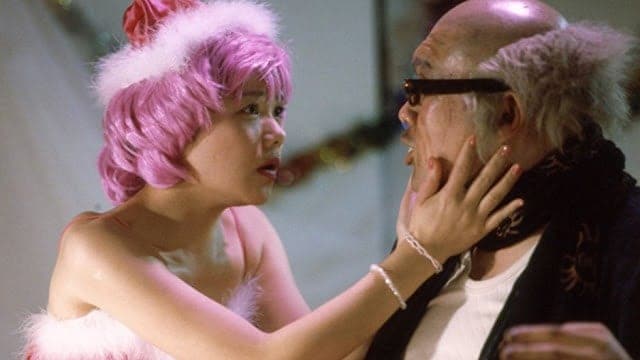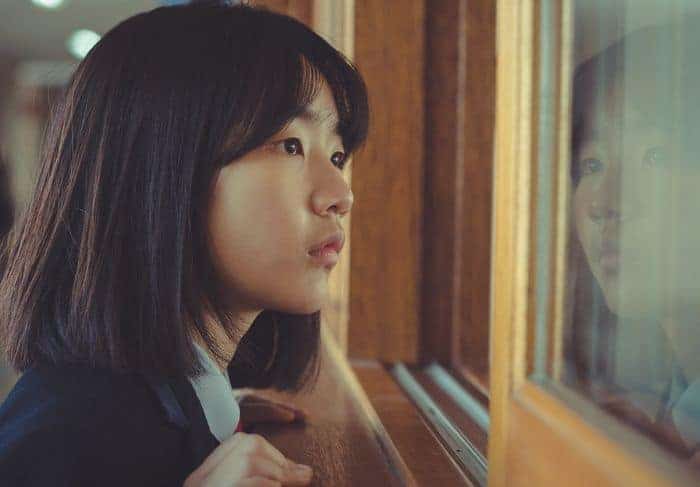Although “Chiwawa” was the film that truly cemented the artfulness of his slightly disorienting, filled with (neon) colors and music, sexually charged style, it is interesting to examine the path Ken Ninomiya followed to reach that level, with his previous movie providing a great opportunity.
Buy This Title

The story revolves around Aki Oria, a young girl who came to Tokyo ten years ago to become an actress, but eventually ended up staying in a circus of sorts, having a relationship with Kaito, the young man who introduced her, and acting as the magician's assistant, with her role being pretending to be hypnotized. Eventually, she manages to land a part after a successful audition, even becoming a star, before a scandal takes a significant toll to her reputation. Is that the reality though? And who is this clown-like figure she calls Butch that seems to always be with her? And why is that bedroom placed in a roof of a building? As Aki begins to lose her grip with reality and succumb to confusion, so does Ninomiya lead his audience down the same path.
Handling such a difficult narrative, which has the borders of reality and schizophrenia becoming almost non-existent, is not exactly the easiest thing to do, and Ninomiya seems to have made an average job in that aspect. On the one hand, the psychological status of Aki and the way she is led down a path of self-destruction is quite intriguing, with the presence of Butch highlighting from the beginning that something is wrong here. Furthermore, the last part, that essentially shows what is happening, to a point at least, is also well-presented, even if Ninomiya's purpose was never to let the audience be fully convinced about the real events.
Amidst those two elements, however, he succumbs to an effort to impress with his ideas, to the point that the narrative becomes nonsensical and unpleasantly delirious, even if the visual aspect compensates. Particularly the suicide of Kaito, which was essentially the second turning point in Aki's life, after her initial meeting with him, could be handled a lot better in order to be presented with the same impact as its importance in the script. Furthermore, and despite some rather pointy, and quite realistic remarks on how show business in Japan works (so many have suffered from even the slightest “cut” in their impeccable reputation, with Toshiaki Toyoda, Erika Sawajiri and Pierre Taki being the first that come to mind), the overall narrative seems somewhat naive, particularly in the way Aki's actual (?) life progresses.
On the other hand, Ninomiya also has a lot working for him. The fact that he shows a tendency to both adore and torture his protagonist, is one of the best aspects of the narrative, with Yuki Sakurai embellishing this approach with her acting in both cases. The way she portrays a number of different psychological statuses, including happiness, love, despair and madness is captivating, despite the fact that occasionally her performance is blurred by the deliriousness of the story and the intense music video aesthetics. The film also benefits the most by her obvious beauty and sensualism, with Ninomiya showing her nude in a number of artful (erotic) scenes, that definitely add to overall visual brilliance of the movie. The second most memorable performance in the film comes from Niino Furuhata as Butch, who functions as the personification of Aki's thoughts quite convincingly; in another performance that fits the narrative nicely.
This visual aspect owes much to DP Daisuke Soma, who creates a number of images of kaleidoscopic-like beauty, while the play with colors and lights in the movie is one of its best aspects. The combination of his work with Shintaro Matsumoto's productions design is equally artful, with the bedroom in the roof in particular being an ingenious composition, also highlighting Ninomiya's prowess in that regard.
His own editing, however, as mentioned before, could have been somewhat better, while a couple of scenes, which simply seem to promote music tracks through their music video aesthetics, could be omitted altogether. According to themoviebeat.com, Ninomiya originally made “The Limit of Sleeping Beauty” as a medium length independent film, but when King Records label approached him and asked for a full length feature, he agreed to do so, which explains the reason behind these scenes. On the other hand, the techno-pop premises of the soundtrack are quite fitting to the whole narrative, while the combination of image and sound Ninomiya implements is definitely of eye-candy level.
“The Limit of Sleeping Beauty” is not on the level of “Chiwawa”, but there are enough traits here to deem the film entertaining to say the least, while fans of the visual style of Mika Ninagawa and Tetsuya Nakashima will definitely have a blast.















